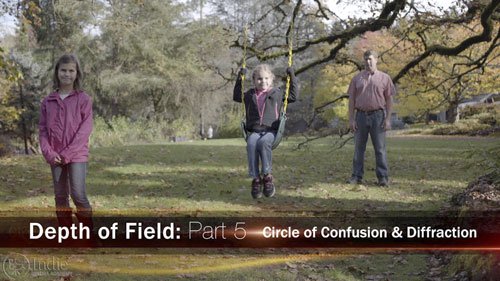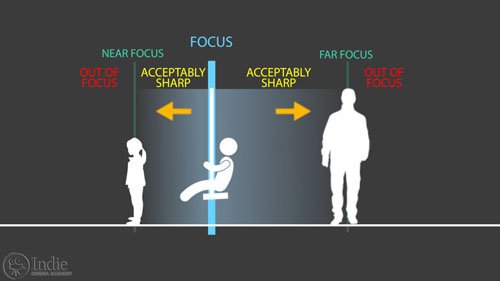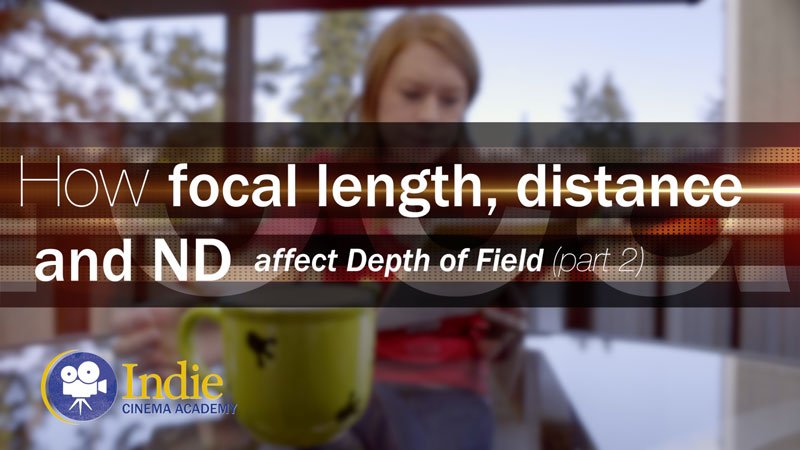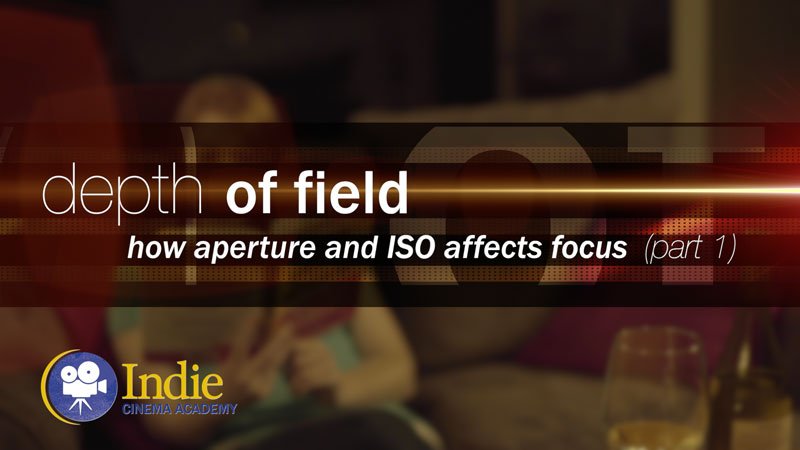Depth of Field, Part 5:
How Circle of Confusion and Diffraction Blur Your Image
Written and presented by Tim Park
Summary: In Part 5 of our series on depth of field we explore two things than can blur your image: light diffraction and circle of confusion. Both are important to understand so that you get the sharpest image possible.
Length: 9:03 minutes
!! Want to see the whole video? Become a member !!
- If you are already a member, you can log in below.
Introduction
Now that you have a basic understanding of what depth of field is, how to use a depth of field calculator, and how to move your range of focus around your set such as with hyperfocal distance, it is time to get into the messy side of depth of field where objects that are supposed to be in focus still are a bit blurry.
Truth be told even we had some issues with things not always being acceptably sharp as we shot footage for these lessons. So in this lesson we’re going to discuss two topics that can ruin your depth of field: light diffraction and something called “circle of confusion.”

What is “Acceptably Sharp”?
As we’ve covered in previous lessons, depth of field is about the range of distances that appear to be acceptably sharp. However technically, only a very specific area is in focus: the exact distance you’ve focused your camera. Objects in front and behind this area of focus may APPEAR to be in focus, but if you look closely they actually aren’t. They are ever so slightly out of focus even if you can’t tell in the finished shot. This is why we repeatedly described depth of field as an “acceptably sharp” region instead of simply saying the area was sharp.

Additionally, our graphics in previous lessons showed this “acceptably sharp” depth of field as an absolute range between the near focus and far focus limits. But it isn’t like as you move through this field everything is in perfectly in focus and then *suddenly* when you cross a boundary it’s instantly out of focus. Instead, the better way to think of depth of field is a gradient moving gradually from what is in focus to what isn’t in focus. Gradually as you move away from the plane where objects are truly in focus, things will slowly become less “acceptably sharp.”

So now is the time to talk about the dirty little secret of depth of field: how is “acceptably sharp” defined? …
** Want to read the rest of the transcript? Become a member. **
Camera / Audio
- Sony Alpha a7S Mirrorless Digital Camera
- Rokinon Cine DS 6 Lens Kit with Sony E Mount
- Bright Tangerine Misfit Matte Box
- TruND Neutral Density Filters (4″x5.65″): 0.3, 0.6, 0.9, 1.2, 1.5
- Tilta FF-T03 15mm Follow Focus with Hard Stops
- Sachtler Panorama 7+7 Head 100mm (similar head: 1006 DV 10 SB Fluid Head)
- Sachtler Carbon Fiber Tripod (similar tripod: Carbon Fiber HD Tripod Legs)
- Movcam Cage for Sony A7S
- Wooden Camera A/B Gold-Mount Plate for Sony A7, A7r and A7s
- Audio Technica AT835b Shotgun Microphone
(similar microphone: Audio Technica BP4071 Shotgun Microphone)
- Rode Podcaster USB Microphone
- Microphone Pop Filter
- Wooden Camera DSLR A-Box
- Delkin Devices 64GB SDXC Memory Card 600x UHS-I
- DSC Labs One Shot Reference Chart (Matte Finish)
- Atomos Shogun 4K Recorder and 7″ Monitor
- SanDisk Extreme PRO-Series Solid State Drive
Calibration/Focusing Charts
Lighting / Grip Gear
 https://indiecinemaacademy.com/wp-content/uploads/2017/01/DoF05_Circle_of_Confusion_and_Diffraction-Thumbnail.jpg
450
800
Tim
https://indiecinemaacademy.com/wp-content/uploads/2013/12/Indie_cinema_Logo_2color-MF-300x116-web.png
Tim2017-01-08 22:45:252025-03-11 14:50:12Depth of Field, Part 5: How Circle of Confusion and Diffraction Blur Your Image
https://indiecinemaacademy.com/wp-content/uploads/2017/01/DoF05_Circle_of_Confusion_and_Diffraction-Thumbnail.jpg
450
800
Tim
https://indiecinemaacademy.com/wp-content/uploads/2013/12/Indie_cinema_Logo_2color-MF-300x116-web.png
Tim2017-01-08 22:45:252025-03-11 14:50:12Depth of Field, Part 5: How Circle of Confusion and Diffraction Blur Your Image https://indiecinemaacademy.com/wp-content/uploads/2016/11/ICA_DOF04_Using_a_DOF_Calculator-Thumbnail-web.jpg
450
800
Tim
https://indiecinemaacademy.com/wp-content/uploads/2013/12/Indie_cinema_Logo_2color-MF-300x116-web.png
Tim2016-11-22 13:39:542025-03-11 14:49:44Depth of Field Part 4: Using a DOF Calculator + Advanced Tips and Tricks
https://indiecinemaacademy.com/wp-content/uploads/2016/11/ICA_DOF04_Using_a_DOF_Calculator-Thumbnail-web.jpg
450
800
Tim
https://indiecinemaacademy.com/wp-content/uploads/2013/12/Indie_cinema_Logo_2color-MF-300x116-web.png
Tim2016-11-22 13:39:542025-03-11 14:49:44Depth of Field Part 4: Using a DOF Calculator + Advanced Tips and Tricks https://indiecinemaacademy.com/wp-content/uploads/2016/11/ICA_DOF03_Hyperfocal_Distance-Thumbnail.jpg
450
800
Tim
https://indiecinemaacademy.com/wp-content/uploads/2013/12/Indie_cinema_Logo_2color-MF-300x116-web.png
Tim2016-11-07 01:15:062025-03-11 14:48:57Depth of Field, Part 3: Hyperfocal Distance
https://indiecinemaacademy.com/wp-content/uploads/2016/11/ICA_DOF03_Hyperfocal_Distance-Thumbnail.jpg
450
800
Tim
https://indiecinemaacademy.com/wp-content/uploads/2013/12/Indie_cinema_Logo_2color-MF-300x116-web.png
Tim2016-11-07 01:15:062025-03-11 14:48:57Depth of Field, Part 3: Hyperfocal Distance https://indiecinemaacademy.com/wp-content/uploads/2016/10/ICA_DoF02_Distance_and_ND_Filters-Thumbnail_web.jpg
450
800
Tim
https://indiecinemaacademy.com/wp-content/uploads/2013/12/Indie_cinema_Logo_2color-MF-300x116-web.png
Tim2016-10-24 08:00:022025-03-11 14:48:27Depth of Field Part 2: How Focal Length, Distance, and ND Affect Depth of Field
https://indiecinemaacademy.com/wp-content/uploads/2016/10/ICA_DoF02_Distance_and_ND_Filters-Thumbnail_web.jpg
450
800
Tim
https://indiecinemaacademy.com/wp-content/uploads/2013/12/Indie_cinema_Logo_2color-MF-300x116-web.png
Tim2016-10-24 08:00:022025-03-11 14:48:27Depth of Field Part 2: How Focal Length, Distance, and ND Affect Depth of Field https://indiecinemaacademy.com/wp-content/uploads/2016/10/ICA_DoF01_How_Aperture_and_ISO_Affects_Focus-Thumbnail-web.jpg
450
800
Tim
https://indiecinemaacademy.com/wp-content/uploads/2013/12/Indie_cinema_Logo_2color-MF-300x116-web.png
Tim2016-10-10 00:15:202025-03-11 14:46:47Depth of Field, Part 1: How Aperture and ISO Affect Focus
https://indiecinemaacademy.com/wp-content/uploads/2016/10/ICA_DoF01_How_Aperture_and_ISO_Affects_Focus-Thumbnail-web.jpg
450
800
Tim
https://indiecinemaacademy.com/wp-content/uploads/2013/12/Indie_cinema_Logo_2color-MF-300x116-web.png
Tim2016-10-10 00:15:202025-03-11 14:46:47Depth of Field, Part 1: How Aperture and ISO Affect Focus https://indiecinemaacademy.com/wp-content/uploads/2015/12/CS006-HighSpeed-Part06-FREE-Thumbnail-Web.jpg
450
800
Ryan E. Walters
https://indiecinemaacademy.com/wp-content/uploads/2013/12/Indie_cinema_Logo_2color-MF-300x116-web.png
Ryan E. Walters2015-12-14 00:15:052015-12-29 13:20:06Your Guide To High Speed, Part 6: Five Tips For A Successful Shoot
https://indiecinemaacademy.com/wp-content/uploads/2015/12/CS006-HighSpeed-Part06-FREE-Thumbnail-Web.jpg
450
800
Ryan E. Walters
https://indiecinemaacademy.com/wp-content/uploads/2013/12/Indie_cinema_Logo_2color-MF-300x116-web.png
Ryan E. Walters2015-12-14 00:15:052015-12-29 13:20:06Your Guide To High Speed, Part 6: Five Tips For A Successful Shoot https://indiecinemaacademy.com/wp-content/uploads/2015/12/CS005-HighSpeed-Part05-FREE-Thumbnail-Web.jpg
450
800
Ryan E. Walters
https://indiecinemaacademy.com/wp-content/uploads/2013/12/Indie_cinema_Logo_2color-MF-300x116-web.png
Ryan E. Walters2015-11-30 09:00:282015-12-29 15:41:16Your Guide To High Speed, Part 5: Lighting Six High Speed Sets
https://indiecinemaacademy.com/wp-content/uploads/2015/12/CS005-HighSpeed-Part05-FREE-Thumbnail-Web.jpg
450
800
Ryan E. Walters
https://indiecinemaacademy.com/wp-content/uploads/2013/12/Indie_cinema_Logo_2color-MF-300x116-web.png
Ryan E. Walters2015-11-30 09:00:282015-12-29 15:41:16Your Guide To High Speed, Part 5: Lighting Six High Speed Sets https://indiecinemaacademy.com/wp-content/uploads/2015/12/CS004-HighSpeed-Part04-FREE-Thumbnail-Web.jpg
450
800
Ryan E. Walters
https://indiecinemaacademy.com/wp-content/uploads/2013/12/Indie_cinema_Logo_2color-MF-300x116-web.png
Ryan E. Walters2015-11-16 00:15:182015-12-29 13:17:26Your Guide To High Speed, Part 4: Common Lighting Problems
https://indiecinemaacademy.com/wp-content/uploads/2015/12/CS004-HighSpeed-Part04-FREE-Thumbnail-Web.jpg
450
800
Ryan E. Walters
https://indiecinemaacademy.com/wp-content/uploads/2013/12/Indie_cinema_Logo_2color-MF-300x116-web.png
Ryan E. Walters2015-11-16 00:15:182015-12-29 13:17:26Your Guide To High Speed, Part 4: Common Lighting Problems https://indiecinemaacademy.com/wp-content/uploads/2015/12/CS003-HighSpeed-Part03-FREE-Thumbnail-Web.jpg
450
800
Ryan E. Walters
https://indiecinemaacademy.com/wp-content/uploads/2013/12/Indie_cinema_Logo_2color-MF-300x116-web.png
Ryan E. Walters2015-11-02 00:15:272015-12-29 13:15:49Your Guide To High Speed, Part 3: Camera Operation & Workflow
https://indiecinemaacademy.com/wp-content/uploads/2015/12/CS003-HighSpeed-Part03-FREE-Thumbnail-Web.jpg
450
800
Ryan E. Walters
https://indiecinemaacademy.com/wp-content/uploads/2013/12/Indie_cinema_Logo_2color-MF-300x116-web.png
Ryan E. Walters2015-11-02 00:15:272015-12-29 13:15:49Your Guide To High Speed, Part 3: Camera Operation & WorkflowLeave a Reply
Want to join the discussion?Feel free to contribute!
Leave a Reply Cancel reply
You must be logged in to post a comment.
This site uses Akismet to reduce spam. Learn how your comment data is processed.

What level of membership would I need to be able to watch your DoF Part 5 video on circle of confusion? Gary.
Hi Gary, The DoF series is part of the Camera Foundations Module, so that would be the membership you would need to purchase.